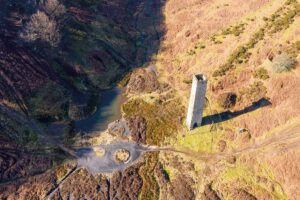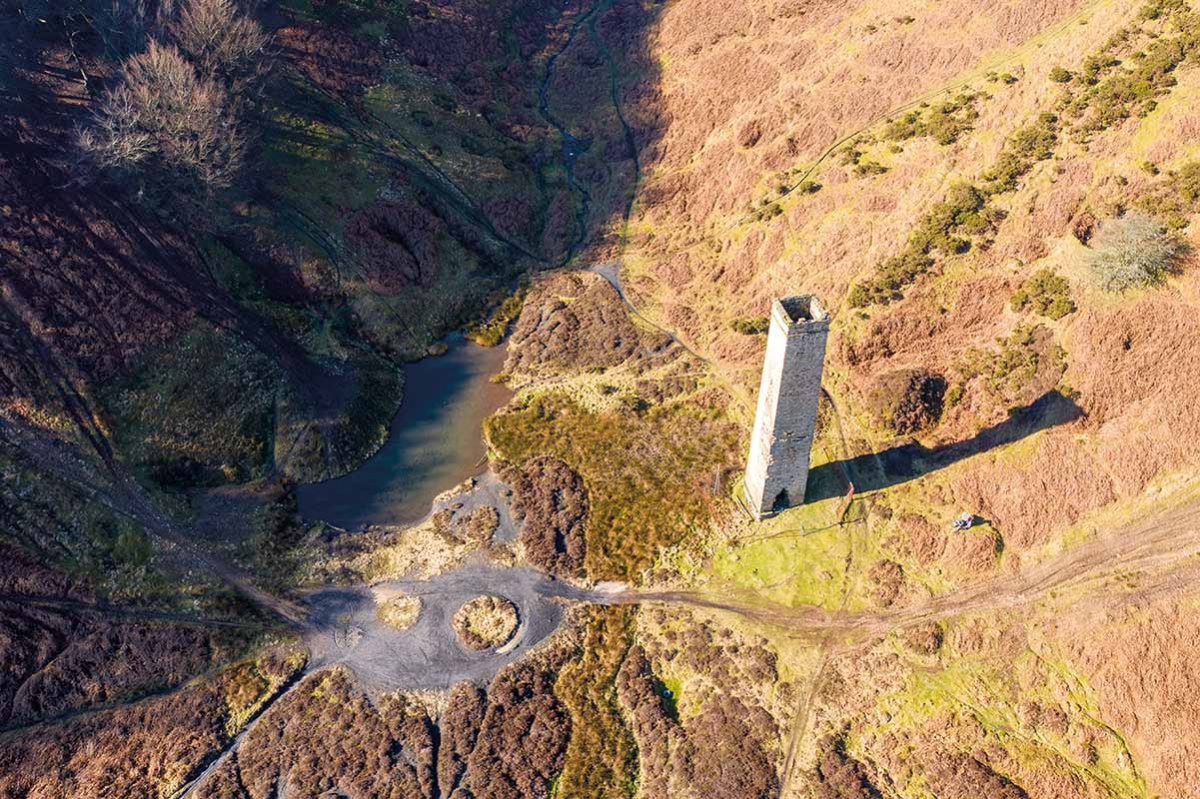From Geographical website
The UK has made little progress decarbonising heating, but a significant source lies freely available under the feet of a quarter of the population

By Catherine Early
On an industrial park outside Gateshead, a pioneering technology is extracting energy from Britain’s past and using it in a way that could herald its low-carbon future. Not content with generating electricity from wind turbines and solar panels for its factory, contract wine-bottling company Greencroft Bottling wanted a low-carbon method to heat its two warehouses that store 20 million bottles. While searching for the right technology, company director Adam Black realised that the warehouses were situated above a huge source of heat – a former coalfield whose disused mines were flooded with water naturally heated by geothermal processes to around 17°C.
Black tracked down an expert in geothermal energy from Iceland and a water source heat pump system was installed, transforming the warehouses into the first commercial use of mine-water heat in the UK. Black expects the company’s £3.5 million investment to pay for itself within five to ten years.
‘The exciting thing about this technology is that heating is one of the hardest things to decarbonise and here we are with these mines directly under where we need it,’ says Black.
This is just a snapshot of the potential for using the geothermal heat found in mine water. One-quarter of the UK’s residential properties sit on coalfields, according to the Coal Authority, the government body responsible for former coal-mining assets. It believes that the water in those fields has huge potential to provide a low-carbon energy source for homes and businesses in former coal-mining areas in Wales, the Midlands and the north of England.
The mine water is heated by geothermal processes, is constantly replenished and maintains a stable temperature. According to the Coal Authority’s calculations, there’s theoretically enough water to provide all of the heating needs for the populations in the coalfields, as well as being used by local businesses working in areas such as horticulture and manufacturing.
Water is extracted from the mines by drilling boreholes down until they reach the water, the depth of which varies among sites. Heat from the water is transferred to a pipe network using an above-ground heat exchanger and then distributed to nearby homes through a district heating network. The Coal Authority is already working with several local authorities to investigate the feasibility of 30 such projects.

The largest is at Seaham, a seaside town in County Durham, where a new 1,500-home development could become the first large-scale mine-energy district heating scheme in the UK. It’s to be built next to the Coal Authority’s existing Dawdon mine water treatment scheme, which pumps up to 150 litres of mine water a second to the surface.
The water is at a constant temperature of 18–20°C, and could provide 6MW of low-cost, low-carbon heat. The council is investigating the feasibility of the heat network with the developer, Tolent Construction, but the project has secured funding from the government’s £320-million Heat Network Investment Programme. A district heat network using mine water would be much cheaper than is typical for such networks as the water is at a relatively low temperature and therefore doesn’t need metal pipes. ‘Coal mining damaged the environment and created communities that are now suffering from poverty, isolation and unemployment. To be able to use the heritage of the disused and flooded mines to generate heat for the whole village would be great,’ says Maggie Bosanquet, low-carbon economy team leader at Durham County Council.
Mine-water heat networks are also being investigated in Hebburn near Newcastle, where the heat could be used in council-owned buildings; in Gateshead, where the council is planning to connect an existing heat network to a mine-water treatment scheme; and in Nottingham, where the city council is working with the Coal Authority to build a district heat network, initially to heat around 60 council homes, but with a view to rolling the network out across the city.
In Wales, Bridgend County Borough Council is investigating how heat from the former Caerau colliery could warm around 150 nearby homes. These schemes are being funded through a combination of money from the government, the EU and local authorities. By the mid-2020s, the UK could have as many as five to ten operational mine-heat networks, generating 2–5MW each, according to research published by the Durham Energy Institute (DEI).
‘The mine-water heat is super low impact; there’s nothing to see on the surface,’ says Jon Gluyas, director of the DEI. ‘It’s already proven and working. In the northeast, Nottinghamshire, Sheffield, Keele and the Midland Valley of Scotland – all are starting to buy into this. When we talk to former mining communities they love the idea. The fracturing and disruption of the cohesion within the community occurred post-closure of the coal mines and the idea that you might be able to resurrect some of that around mine-water heat plays very well into that narrative of the rebirth of communities. And certainly, we’ve had very good responses from mining communities.’

Mapping the potential
The Coal Authority and the British Geological Society (BGS) have developed a free interactive map of former coal mines to demonstrate the potential to local and central government, developers, researchers and consultants (see static version above). The map shows where the mines are and the extent to which temperatures increase with depth, as well as areas where warm water has been abstracted by pumping, meaning that the heat can be harvested without drilling into the workings.
It’s the first time that these data have been brought together in this way. BGS geoscientist Gareth Farr, who led the project, explains how the maps were created: ‘There was no single dataset that covered the whole country using one method, so we started off with a mixed bag of very modern, very high-resolution data from the Coal Authority, data from the Environment Agency and our own archives, and data from when the mines were operational, going back to the 1800s – that was the fun bit with all the leather-bound books,’ he says.
The BGS took historical records of temperatures going back more than 100 years and compared them to current temperatures in the mines, and found them to be quite similar. ‘This is a clear indication that the geothermal processes that create this heat will be here for a long time to come,’ Farr says. The research behind the maps was published in the Quarterly Journal of Engineering Geology and Hydrogeology. The BGS has also built a geothermal research observatory in Glasgow, which is being used to increase understanding of the potential for disused mine water to be used for renewable heating.
UK decarbonisation
Heating is proving to be a tricky piece of the UK’s decarbonisation puzzle. It accounts for half of UK energy demands, with more than three-quarters of that generated by burning fossil fuels, mostly gas, the DEI says. As a result, heating is responsible for some 37 per cent of our greenhouse gas emissions, according to the Energy Savings Trust. In its latest progress report, the Committee on Climate Change, the UK’s independent adviser, stated that decarbonising heating was ‘barely yet addressed’.
The government is phasing out gas heating for new-build homes from 2025. Alternatives, such as ground- or air-source heat pumps, are expensive, while hydrogen is still at feasibility stage. Swapping home heating over to electricity would require a huge scale-up of renewable-energy generation and put pressure on the grid.
The Coal Authority believes that the mine-energy schemes could be the answer for a significant proportion of demand, providing a source of heat that will be cost-competitive with gas but with a carbon footprint that is less than ten per cent that of gas – or zero if the heat pumps are powered by renewable electricity.

The underground water in the mines could also be used to store excess renewable heat from solar thermal generation in the summer and waste heat from industrial processes, which could then be used when demand is higher in the winter. The DEI researchers concluded that the theoretical potential for underground thermal-energy storage in the UK is much larger than is likely to be needed in practice, and recommended further research on costs.
‘That would be a game changer in the UK’s energy strategy, because the missing part of the strategy is how you take all of the waste and surplus energy that’s available and store it so that you can use it when you need it,’ says Jeremy Crooks, head of innovation at the Coal Authority.
Jobs potential
Mine-heat schemes could also be hugely beneficial socially and economically. Coalfield communities typically suffer from high levels of unemployment and deprivation caused by the closure of pits during the 1980s and ’90s. As well as low-cost energy, the mine-heat schemes would create jobs – not only working directly for them, but also indirectly, according to Crooks.
‘In ten years’ time, businesses looking at where to site their operations will be looking at the coalfields first because they will be where the low-cost, low-carbon energy is. The closure of the mines had a detrimental impact on communities, but we think that will actually reverse – these will be the places to invest in, which will create jobs,’ he says.
The fact that abandoned mines could be put to positive use could provide a psychological, as well as economic, boost to local people, particularly in Seaham, according to Lynn Gibson, company secretary and director of the Durham Mining Museum, whose own family mining heritage dates back three centuries.
‘Seaham was one of the last big pits to shut, in 1983,’ she says. ‘It has some of the highest unemployment rates and number of benefit claimants in the whole country. To see something positive come out of it, where people aren’t going to be injured or put their lives at risk any more, would be great.’

Retrofitting challenge
Meeting the full potential of mine-water heat schemes will mean finding ways to make retrofitting of existing homes financially viable. The return on investment for using the heat in new homes is fast, and the same goes for existing industrial buildings, Crooks says. Existing homes, however, are more problematic, due to the need to drill the boreholes around established utilities in roads, connect into residents’ existing heating systems and deal with old houses that aren’t well insulated. Local authorities could identify groups of homes where the economics could be traded off, so that the buildings that have good returns on investment effectively subsidise the ones that don’t, Crooks suggests.
The Coal Authority originally started looking into how to use mine-water heat as a way of generating some value from the abandoned mines, which were considered a liability. The Authority, which has a static budget, was facing ever-higher costs from installing and operating plants to treat the water, which is highly toxic and has the potential to cause significant pollution in nearby rivers, killing wildlife.
However, its work on mine-water heat has turned this thinking on its head, Crooks says. ‘What we’ve realised is the mines aren’t a liability at all – they’re actually an asset of strategic importance to the UK. Our focus is now not on how we’re going to fund more mine-water treatment schemes, it’s more about how we contribute to the government’s climate change strategy and make sure that these schemes happen on the largest scale possible.’
Mine-water heat in Spain and the Netherlands
Heerlen, a city and municipality in the southeast of the Netherlands, was at the heart of a Dutch coal-mining area that closed its last mine during the 1970s. In 2008, abandoned coal mines beneath the city were brought back into use to supply heat to 350 homes and businesses in the town. Over the years, its operators, Mijnwater B.V., created a new type of district heating network that supplies both heating and cooling via a closed-loop system that exchanges energy underground. The company has now connected 250,000 square metres of building space, and reduced their carbon emissions by up to 65 per cent. Like many former coal-mining areas, Heerlan had been economically depressed, but the heating network has revived its fortunes, according to Herman Eijdems, director of innovation and strategy at Mijnwater B.V. The project has also been good for energy security, he says. ‘The region spends €500 million a year buying fossil fuels and 98 per cent of that is from outside the area. But a lot of the equipment for the mine heat, such as pipes, can be bought locally. We are building infrastructure to avoid buying fossil fuels,’ he says.
In Spain, state mining company Hunosa is in a similar position to the Coal Authority. It, too, is responsible for pumping water out of disused mines and keeping it at safe levels to avoid damage to buildings and other infrastructure. Using the geothermal energy in the mine water is seen as a potential way to make money from it, as opposed to viewing it as a waste product. The company’s first facilities in Mieres in northern Spain began operating in 2014, providing heating and cooling to the town’s hospital, a university building and a research facility. In 2020, a district heating scheme began supplying the residential buildings, a secondary school and the main university building. A similar project, under construction in nearby Langreo, will supply homes, a sports centre and a public health centre. Hunosa guarantees its prices at lower costs than traditional fossil fuel sources, explains the firm’s head of innovation, Noel Canto, adding that people were a little sceptical of the technology at first. ‘People didn’t believe us in some ways, but the first facility we built supplied the hospital, and it was successful, so it was a very good start for our projects,’ he says.



